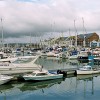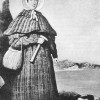Sometimes referred to as the capital of the Marshwood Vale, the village of Whitchurch Canonicorum in West Dorset has a parish church with an appropriately grandiose exterior like a mini cathedral. The church dates from before the 13th century and is dedicated to a most unusual and obscure patron in a county in which so many churches are dedicated simply to Mary or John.
This account is not however concerned with a general history of the church, but specifically on an enigmatic patron saint and a unique monument within its walls. The ecclesiastical figure in question is St. Wyte – (or Wite, Witta, Blance, Albinus, Candida or Candidus,) a saint of several alternative names and almost as many theories about her identity.
One of these is that she was a Saxon princess or recluse, possibly companion of Boniface, who was martyred by invading Danes coming ashore at Charmouth. It is known that St. Boniface was born in the Marshwood district, but it is uncertain whether Witta was a local figure or not. Here arises the possibility that the dedication became confused or altered to Candida under foreign influence, for Candida is said to have been a Roman or Spanish virgin martyr. A second myth maintains that she was actually a Welsh saint called Gwen, while yet another holds that “she” is to be identified as Albinus, Bishop of Buraburg. Fourthly, Blanche is the native French name for a Norman saint who has been put forward as another claimant on her identity.
As these various appellations mean ‘white’ it is thought that this adjective also lies behind the origin of the parochial name “Whitchurch.” Several small manors comprise the parish, but none of these has given its name to the whole. Therefore it has been suggested that it was the church itself, possibly known by the Latin name of Ecclesia Candida, which later became Angliased to Whitchurch. Whatever the truth however, there is no doubt that a burial or inhumation took place above the monument in the parish church of St. Candida & Holy Cross at Whitchurch, today known as the Shrine of St. Candida.
The shrine is a 13th century roughly cast stone monument showing clear indications of having been added to at various stages or being a composite from various sources. It stands on a base in an alcove against the north wall of the church’s north transept. The west end of this base can be seen to be contiguous with the transept wall, but projecting some three inches beyond at the east end, so that the structure is not entirely parallel to the wall. Furthermore, there is a disparity of about three inches in the height of the shrine at each end of the church as there is a slight gradient in the pavement of the transept from west to east.
The lower part of the monument gives the appearance of having been a 13th century altar tomb reset into its present position at an unknown date. This repositioning was crudely carried out, so that it interferes with the engaged pilasters at each end. Three evenly-spaced elliptical apertures are set into the monument from front to back, their purpose apparently being the cavities into which people placed their diseased limbs while they prayed for the saint to restore them to health. Above, the structure is surmounted by an unadorned 14th century stone reliquary resting upon an earlier slab and sealed with a hollow-chamfered slab of partially eroded Purbeck marble. The coffin was found to contain the bones of a small woman when, it is said, it was opened around 1850 by the incumbent of Whitchurch at the time, the Revd. William Palmer.
The outer coffin bears no inscription, but when it was later opened again during repairs to the church wall in 1900, the reliquary was found to bear the inscription ‘Hic. Requesct. See Wite’ (here lie the remains of St. Wite.) No one quite knows the whereabouts of these remains today. Presumably the bones and the small casket containing them were returned to the coffin. However, during the original disturbance by Reverend Palmer in the 19th century the side of the coffin was fractured, leaving a crack in the side that can still be seen today. Nevertheless, it remains a fact that St. Candida & Holy Cross is the only church in England to traditionally contain the tomb of its own patron saint.
Not far from Whitchurch there is a well also dedicated to St. Candida, but before describing this there are two other notables connected with the church that deserve a mention.
Sir George Somers was a contemporary and fellow mariner of Sir Walter Raleigh, a sometime mayor of his birthplace Lyme Regis and an MP largely responsible for the colonisation of Virginia. During a storm a fleet of nine of his ships carrying settlers was grounded on one of Bermuda’s coral islands, which Somers took possession of. The settlers later completed the voyage to Virginia by building new boats, but after word of the castaways reached England, the venture inspired Shakespeare to write ‘The Tempest.’
Somers died in 1610 on a voyage back to Bermuda. His heart was buried there, but his body was brought home and buried in St. Candida & Holy Cross.
In the churchyard there is a memorial stone marking a grave, inscribed in English on one side and in Bulgarian on the other. The Bulgarian inscription is there because this is the grave of the dissident BBC World Service broadcaster and journalist Georgi Markov, who died after being injected with a lethal ricin pellet by a regime-hired Communist assassin on Waterloo Bridge in London during September 1978.
The well of Candida, known under the name of St. Wyte’s Well, is to be found at nearby Morcombelake on the further side of the Chardown Hill. It is situated at the extreme western end of the village, near to where the A35 takes a double bend southwards over the hills and leads to a narrow lane between farm buildings. Here a painted sign will direct you to the well about 300 yards up a muddy track (OS Sheet 193; GR398937.) Here, fenced off in its own enclosure is the well, which takes the form of a square stone-lined basin measuring about 1 foot by 1 foot five inches. The water level is about 8 inches below the kerb, and the water is typically well-colonised by algae. A modern plaque explains that this water has been blessed with the ability to cure eye diseases since the 16th century, but it is not above being able to cure other maladies.



